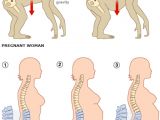You may wonder how pregnant women, with those continuously growing bellies, don't lose balance, toppling over. A new Harvard research published in "Nature" has found some evolutionary tricks: slight differences from men in the lower backs and hip joints enable women to cope with pregnancy. And the adaptive pattern was spotted only in women and the females of our immediate ancestors who were bipedal (walked on two feet), but not in chimps and other apes.
"That's a big load that's pulling you forward. You experience discomfort. Maybe it would be a lot worse if (the design changes) were not there", said co-author Liza Shapiro, an anthropology professor at the University of Texas and a fresh mother.
Harvard anthropology researcher, Katherine Whitcome, found two physical differences in male and female backs that scientists have not noticed till now: one lower lumbar vertebra (in the loin area) is wedged-shaped in women and more square in men, which gives a curvier loin to pregnant women; and a main hip joint is 14 % bigger in women than in men, relatively to the body size. Mechanical tests revealed how those minute changes permitted women to carry the load of the growing baby without toppling over or affecting the back (with subsequent back pains).
"Women are experiencing a pretty impressive challenge. Evolution has tinkered ... to the point where they can deal with the challenge. A little bit of tinkering can have a profound effect", said Whitcome.
"Natural selection favored this adaptation because it reduces extra stress on a pregnant female's spine. Without the adaptation, pregnancy would have placed a heavier burden on back muscles, causing considerable pain and fatigue and possibly limiting foraging capacity and the ability to escape from predators. Any mother can attest to the awkwardness of standing and walking while balancing pregnancy weight in front of the body. Yet our research shows their spines have evolved to make pregnancy safer and less painful than it might have been if these adaptations had not occurred", said Shapiro.
Bipedal walking, typical for humans, comes with many costs, including pain for pregnant women, while four-limbed mammals, apes included, can cope easier with the extra belly weight, as it falls relatively comfortably under the belly, whereas in women it pushes the body's center of gravity forward, out of balance.
"The back changes appear to have evolved to overcome the cost of walking on two feet", said Harvard anthropology professor Daniel Lieberman.
Exactly the same pattern like in modern women was found in Australopithecus, a 2 million years old human ancestor. The extra bend of the spine would have allowed pregnant Australopithecus to escape predators.
Still, how do the poor men manage to cope with their large beer bellies, which overcome pregnancies in many cases? "Their back muscles are used to compensate, but that probably means more back pain. It would be a fun study to do to look at men with beer bellies to see if they shift their loads", said Shapiro.

 14 DAY TRIAL //
14 DAY TRIAL // 
